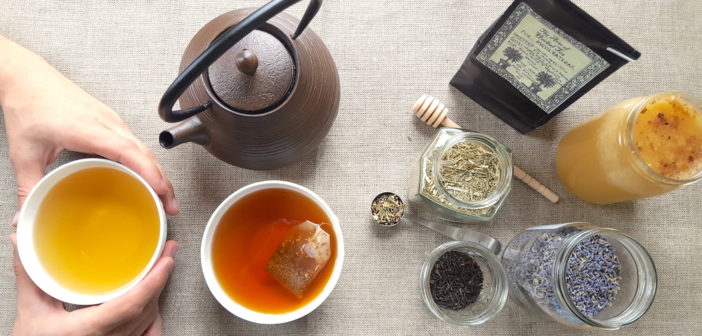“Every tea tasting stimulates each of our five senses to varying degrees. Think of a tasting as a concatenation of micro-events, each engaging a particular sense. Two senses constitute what we superficially refer to as ‘taste,’ but all of them come into play during a tasting,” from Tea Sommelier: A Step-by-Step Guide by François-Xavier Delmas and Mathias Minet.
The most pleasant and efficient way to perfect your tasting skills is to work in small groups. Conversing and sharing impressions will help enhance your experience and build your knowledge.
Protocol For Group Tastings
For the best results, it’s advisable to follow a few rules when organizing a tea tasting:
Choose a theme for the tasting
If each participant brings a favorite tea to share with the others, set a theme (for example: black teas, Chinese teas, etc.). That will make it easier to focus attention on learning and apprenticeship, and not just sharing impressions.
Ideally, the job of selecting the teas to be tasted is assigned to one individual.
Taste several teas
It’s best to taste a least two teas to benefit from making comparisons. Keep in mind that making such comparisons often leads you to focus on differences, while neglecting to note common traits.
Use the right equipment
The versatile tasting set is ideal. Use as many sets as you have teas to taste. You can also use small (10-ounce/300 ml) teapots and cups. In this case, choose small cups—containing one or two swallows—and avoid mugs. If your tasting is focused on a mode of preparation (Gong Fu Cha or Kyusu, for example), use traditional utensils.
Tasting Sets
Developed in England in the late nineteenth century and probably based upon a series of adaptations of Chinese Zhong practices, a professional tasting set has three components: a bowl, a 4-ounce/120 ml cup with a serrated rim, and a cover. The cup and its cover are virtually hermetically sealed and designed especially to retain the fragrances from the infusion process. The taster can inhale the aromas by pouring the contents of the cup into the lid.
Slurp
The term for this approach to tasting speaks for itself—it calls for a noisy gulp. Slurping multiplies the sensations of retronasal olfaction. Get comfortable with each other at the beginning of the session. Abandon your inhibitions by starting the tasting with a resounding collective ritual slurp!
Three Essential Rules
* Except for the slurp, perform the tasting in silence to avoid influencing your neighbors
* Note your impressions on a tasting sheet Tasting Notes
* And, of course, skip the perfume on a tasting day
Communicate to Make Progress
Learning to communicate your impressions with others will give you an incentive to name them with greater precision and go into further detail than if you were tasting alone. When it comes to olfactory and gustatory sensations, our vocabulary is surprisingly imprecise. Sharing thoughts forces us to focus and refine our descriptions.
Progressive Tastings
Here are a few examples of possible themes, based on the group’s level of expertise.
For beginners
- The colors of tea: 1 white tea, 1 green tea, 1 black tea, 1 oolong, and 1 dark tea
- Classic teas: 1 green tea, 1 black tea, 1 breakfast tea, 1 flavored Earl Grey tea, 1 smoked tea, and 1 jasmine tea
- The countries of tea: 1 tea from China, 1 tea from Japan, 1 tea from India, 1 tea from Nepal, and 1 tea from Sri Lanka
For connoisseurs
- 5 Japanese teas: 1 Sencha, 1 Gyokuro, 1 Tamaryokucha, 1 Hojicha, and 1 Genmaicha
- 5 black teas: 1 spring Darjeeling, 1 Yunnan, 1 Qimen, 1 Assam, and 1 black Nepal
- 5 oolongs: 1 classic Tie Guan Yin, 1 Bao Zhong, 1 Oriental Beauty, 1 Da Hong Pao, and 1 Geng Huang Dan Cong
- 5 green teas: 1 Sencha, 1 Long Jing, 1 Nepal green tea, 1 raw Pu Erh, and 1 African green tea
For experts
- 5 spring Darjeelings
- 5 Himalayan black teas (spring, summer, and autumn harvests)
- 3 Lightly oxidized Taiwanese oolongs
- 3 Sencha Ichibancha teas
Blind Tastings
To spice up your tasting experience, replace the tasting sets with black wine glasses. You’re sure to be challenged and perplexed!
This wonderful guide was reprinted with permission from Tea Sommelier: A Step-by-Step Guide, Abbeville Press, 2018.





